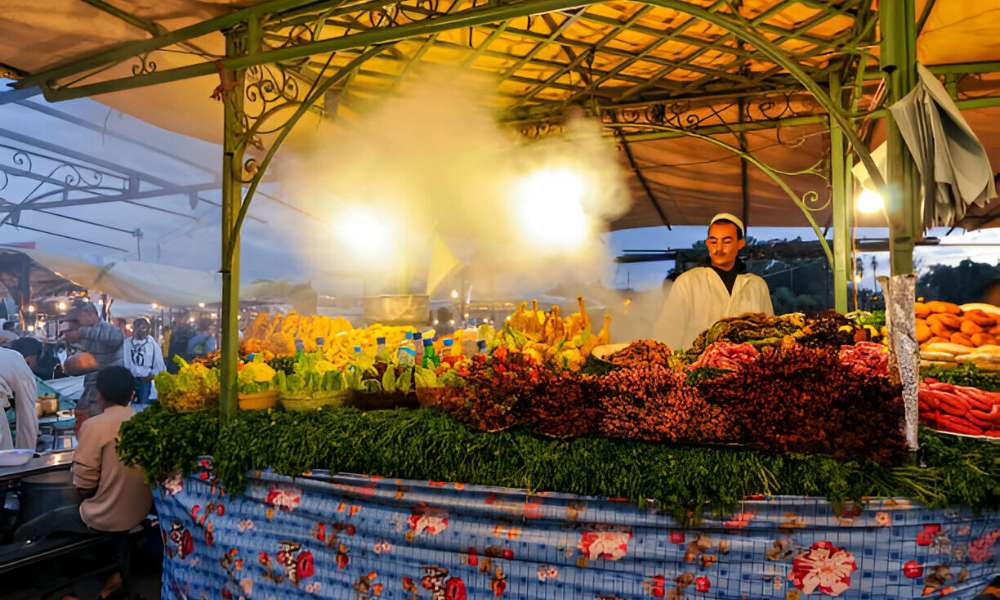Nestled within the bustling labyrinth of narrow alleyways and vibrant marketplaces, the street food stalls of Marrakech offer an intoxicating glimpse into Morocco’s rich culinary tapestry. Here, under the watchful eye of ancient minarets and amidst the melodic calls to prayer, the air is thick with the aromatic blend of spices that define Moroccan cuisine. From the sizzling skewers of marinate meats to the bubbling pots of savory stews, each stall is a portal to a world where flavors tell stories passe down through generations.
In this culinary haven, the fusion of Berber, Arab, and French influences come alive in every bite. Inviting you to explore the tantalizing symphony of tastes that make the street food of Marrakech an unforgettable adventure.
Stall 1: Jemaa el-Fnaa Square’s Grilled Meats
Jemaa el-Fna square is the lively center of Marrakech, famous for its lively atmosphere and food stalls. In between, grilled meat stalls stand out, attracting locals and vacationers with their mouth-watering aroma. Stalls offer plenty of meat, including lamb, red meat and chicken, expertly grilled over open fires. The secret to their tantalizing flavor lies in the specific spice mix and marinade. Which regularly provides cumin, paprika, turmeric and coriander. These spices no longer beautify the taste but replicate Morocco’s rich culinary history. Visitors can enjoy a portion of meat and traditional dips served with clean bread. Making for an original and fulfilling avenue dining pleasure.
Stall 2: Harira Soup Haven
For those who want to taste traditional Moroccan soup, Harira Soup Haven is a must visit stall that is hearty and flavorful. Harira is especially full-size throughout Ramadan, although it is commonly serve to break the fast. This nutritious soup is made from tomato, lentils, chickpeas and lamb or beef stock and is seasoned with a mix of spices like ginger, pepper, turmeric and cinnamon.
Adding bright herbs like cilantro and parsley add freshness to every bowl. At these stalls, haris are usually serve with a squeeze of lemon and a side of dates. Which provide an ideal balance of flavours. The rich, aromatic soup not only warms the most efficient frame but provides a deep connection to Moroccan tradition and hospitality.
Stall 3: Seafood Extravaganza
Nestled amidst the vibrant market atmosphere of Marrakech, the Seafood Extravaganza stall is a haven for seafood enthusiasts. Despite being an inland city, Marrakech gets a clear supply of seafood from close to the Atlantic coast. Ensuring several options including sardines, prawns, squid and octopus. This stall is particularly famous for its use of exclusive Moroccan spices that enhance the natural flavors of the seafood. A typical dish might consist of sardines marinated in a mixture of cumin, coriander, paprika and garlic, then grilled whole.
Additionally, seafood is often to serve with a zesty chermoula sauce, made with sparkling herbs, garlic, lemon juice, and spices. The blend of top seafood and strong flavors makes this stall a standout. Presenting the taste of the sea with a Moroccan twist.
Stall 4: Moroccan Bread and Pastry Stand
Moroccan pastries and pastries are a staple of Marrakech street food, highlighting the country’s rich baking tradition. This stall offers a variety of fresh produce mixed with aromatic spices and herbs, a hallmark of Moroccan cuisine. Traditional breads such as khobaz, flat round breads are often sprinkle with sesame seeds, and mesemen, layers of bread, pan-fried. Are staples in shops called sweet pastries such as Moroccan pancakes, usually serve with honey and butter. Spices like fenugreek, cinnamon and saffron are often use to add depth and brightness to the bread. Whether visitors enjoy simple pastries with olive oil or sweet pastries with mint tea. They will find comforting flavors and aromas that are an integral part of Moroccan culinary culture.
Stall 5: Tangia Masters
At the Tangia Masters stall, visitors can experience one of Marrakech’s most beloved traditional dishes: Tangia. This slow-cooked marvel is named after the earthenware pot in which it is prepared, typically by men in the medina. Tangia is usually made with lamb, though beef can also be used, and is cooked with a variety of spices and preserved lemons. Key spices include saffron, cumin, garlic, and Ras el Hanout, a complex Moroccan spice blend. The meat, combined with a small amount of water and olive oil. Is sealer in the pot and place in the embers of a communal oven to cook slowly for several hours. This method results in exceptionally tender and flavorful meat that falls off the bone.
The Tangia Masters stall offers this dish in its most authentic form, providing a rich, aromatic experience that is deeply root in Marrakech’s culinary heritage.
Stall 6: Fresh Juice and Smoothie Stand
The Fresh Juice & Smoothie Stand is a lively spot that offers a variety of sweet and savory dishes like Marrakech street food. Popular favorites include orange juice, often touted as the best in the world because of the sweetness of Moroccan oranges. And pomegranate juice, which is tart and highly antioxidant, the shop also offers smoothies made with a blend of local fruits like dates. Curd of figs and banana and hints of honey. Mint and ginger are often add to this drink for added flavor and health benefits. The vibrant colors and fresh flavors of the drinks at this stall offer a refreshing and healthy alternative, perfect for a rehydrating and revitalizing day wandering the busy streets of Marrakech.
Stall 7: Snail Soup Spot
The Snail Soup Spot is a distinctive and intriguing stall that offers a truly unique Moroccan delicacy: snail soup, or “babbouche.” This traditional dish, enjoy for both its flavor and suppose health benefits, is make up by simmering snails in a flavorful broth infused with a blend of aromatic spices and herbs. Common ingredients include anise, thyme, mint, and hot peppers, which combine to create a warming and slightly spicy soup. The snails themselves are tender and absorb the rich flavors of the broth.
This stall is often bustling with locals who savor the soup as a comforting street food treat, particularly in the cooler months. The experience of eating snail soup is not just about the taste. But also about partaking in a traditional practice that connects visitors to the culinary and cultural roots of Marrakech.
Stall 8: Kebabs and Brochettes Booth
The Kebabs and Brochettes Booth is a staple of the Marrakech street food scene, offering a variety of grilled skewered meats that are both flavorful and satisfying. This stall features an array of options, including lamb, beef, chicken, and even liver, all marinated in a blend of traditional Moroccan spices before being grilled to perfection over open flames. Key spices used in the marinades typically include cumin, paprika, coriander, and garlic, which impart a rich and smoky flavor to the meats. The skewers are often serve with fresh bread, salads, and a side of spicy harissa sauce.
The sight and smell of the sizzling kebabs draw in crowds, making this booth a popular spot for a quick and delicious meal. The Kebabs and Brochettes Booth not only offers a taste of Morocco’s robust and savory flavors but also showcases the communal and lively spirit of Marrakech’s street food culture.
Stall 9: Sweet Treats Corner
Sweet Treats Corner is a delightful stall that showcases the rich and diverse world of Moroccan desserts. This stall is a paradise for those with a sweet tooth, offering an array of traditional Moroccan sweets that are both decadent and flavorful. Popular choices include Chebakia, a sesame-coated pastry soaked in honey and flavored with anise and cinnamon, and Sellou, a unique confection made from roasted flour, almonds, sesame seeds, and honey. Another favorite is Maamoul, a date-filled cookie that melts in your mouth, often dusted with powdered sugar.
Saffron and orange blossom water are common ingredients that add a fragrant and luxurious touch to these treats. Each sweet is meticulously make up and reflects Morocco’s rich culinary heritage. The Sweet Treats Corner provides a perfect end to a meal or a delightful snack while exploring the vibrant streets of Marrakech, offering a taste of the country’s exquisite dessert traditions.
Stall 10: Traditional Moroccan Tea Stand
The Traditional Moroccan Tea Stand is an essential stop in the Marrakech street food scene, offering an authentic experience of Morocco’s famous mint tea, also known as “atay.” This stall is not just about serving tea; it is about the art and ceremony of tea preparation, which is a cornerstone of Moroccan hospitality. The tea is made from green tea leaves, fresh mint, and generous amounts of sugar, creating a refreshing and sweet beverage. It is typically poured from a height into small, ornate glasses, creating a frothy top layer. The process and presentation are as important as the taste, often perform with a flourish that captivates onlookers.
In addition to the classic mint tea, the stall may also offer variations infused with herbs like verbena or sage. Visiting the Traditional Moroccan Tea Stand is more than just a chance to enjoy a delicious drink; it is an opportunity to engage in a cherished cultural tradition that epitomizes the warmth and generosity of Moroccan hospitality.
Read more: Street Food Extravaganza in Bangkok: Thai Spices and Sweet Treats
Conclusion
As the sun sets over the vibrant city of Marrakech, the street food stalls of Marrakech continue to buzz with energy. Their fragrant offerings drawing both locals and travelers into a shared experience of culinary delight. The journey through these bustling streets reveals more than just food; it unveils the heart and soul of Moroccan culture. Where each dish is a testament to the country’s rich history and diverse influences.
From the first taste of a delicately spiced tagine to the last bite of a sweet, honey-drenched pastry, the flavors of Marrakech linger long after the meal is over. A savory reminder of the warmth and hospitality found in every corner of this enchanting city. As you depart, the memories of these vibrant flavors and the stories they tell will remain with you. Inviting you to return and explore the ever-evolving tapestry of Moroccan cuisine once more.

